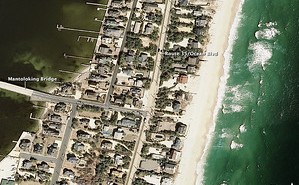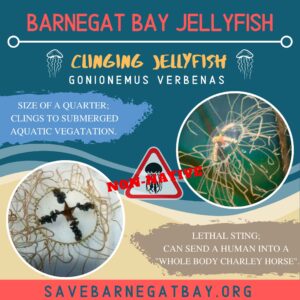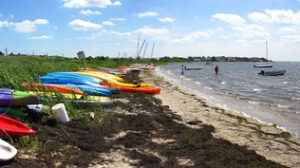WHAT IS STORMWATER?
Stormwater is considered any form of precipitation, including rain, hail, sleet, and snow, that falls from the sky. All forms of precipitation eventually reach the ground and melt into water. Any water that isn’t absorbed into the ground flows over lawns, roads, and sidewalks and becomes stormwater runoff.
While traveling over these surfaces, stormwater runoff picks up chemicals, trash, and bacteria from the ground. The runoff carries these pollutants into local waterways either by directly flowing into streams, lakes, rivers, and bays or entering storm drains that connect to these bodies of water.
HOW DOES STORMWATER AFFECT THE BARNEGAT BAY REGION?
 Over the years, towns along the Jersey Shore have become increasingly more developed. Due to the high demand for beach/bayfront property, houses are becoming larger and closer together. Because of the amount of development, the region around Barnegat Bay is made up of mostly impervious surfaces. These are any surfaces such as roads, sidewalks, rooftops, and parking lots that water cannot penetrate.
Over the years, towns along the Jersey Shore have become increasingly more developed. Due to the high demand for beach/bayfront property, houses are becoming larger and closer together. Because of the amount of development, the region around Barnegat Bay is made up of mostly impervious surfaces. These are any surfaces such as roads, sidewalks, rooftops, and parking lots that water cannot penetrate.
Having large amounts of impervious surface in your town makes stormwater runoff even more dangerous. When it rains in a rural area, the soil and plants absorb the water so there is less runoff. The plants also act as a filter for stormwater by absorbing nutrients before the runoff reaches the waterways. However, towns around the bay have sandy soils and very little vegetation and therefore have nothing to absorb or filter their runoff. Additionally, runoff in towns along the shore drains straight into Barnegat Bay! This makes stormwater runoff a serious concern for Ocean and parts of Monmouth County.
WHY SHOULD YOU CARE ABOUT STORMWATER?
 Polluted stormwater runoff can lead to harmful bacteria and algae in Barnegat Bay. Stormwater runoff can carry nutrients like nitrogen and phosphorus into the bay. Excess amounts of nutrients in the water can lead to an increase in algae and green plants. The rapid increase in algae is referred to as an algal bloom and is most often characterized by green or brown looking water.
Polluted stormwater runoff can lead to harmful bacteria and algae in Barnegat Bay. Stormwater runoff can carry nutrients like nitrogen and phosphorus into the bay. Excess amounts of nutrients in the water can lead to an increase in algae and green plants. The rapid increase in algae is referred to as an algal bloom and is most often characterized by green or brown looking water.
Algal blooms are extremely harmful to an ecosystem because the algae use up all the oxygen in the water and block sunlight from reaching the plants underneath. The lack of oxygen kills all other aquatic life in the area and creates a dead zone where the majority of marine life can no longer survive.
Increases in nutrients in the water can also cause jellyfish blooms, which is the rapid increase in the jellyfish population in a short period of time. Jellyfish are able to tolerate the low oxygen concentration created by algae. However, their predators perish under these conditions. This creates a suitable environment for the jellyfish where they can grow uninhibited.
There has been a huge increase in the number of “bay nettles” in Bay Barnegat in the past 10 to 15 years. These jellyfish can be found almost anywhere in the bay. They have long tentacles that often get wrapped around the body and give a painful sting. Additionally, “clinging jellyfish” have been discovered in Barnegat Bay in the past few years. These jellyfish are much smaller but release a much more powerful sting. To learn more about the presence of jellyfish in Barnegat Bay click here!
HOW WOULD THIS AFFECT HOW YOU USE THE BAY?

Dead zones create an environment that is unfit for most aquatic life including fish, crabs, oysters, and clams. Therefore, commercial and recreational fishing and crabbing on the bay may no longer be feasible. This would take away one of Barnegat Bay’s biggest attractions. Additionally, fresh, local seafood will no longer be available in the area without a healthy ecosystem to support these organisms.
Other sea life like oysters and clams will also no longer be able to live in this environment. These organisms are not only good for harvesting and eating but also help to filter the water to keep the bay clean. To learn more about oysters in Barnegat Bay click here or watch the video on our storyboard at the bottom of this page!
Additionally, water sports and activities such as sailing, swimming, and tubing become less enjoyable and even dangerous due to the presence of jellyfish and harmful bacteria. Many people have begun to avoid swimming in Barnegat Bay because of the growing jellyfish population. The painful sting from the bay nettles has created a fear of the water for many people, and the discovery of clinging jellyfish may even make the bay too dangerous for swimming in certain areas. Harmful bacteria in the water also poses a threat to swimming and other water activities on the bay. High levels of bacteria often force the closing of beaches and swimming areas in the bay.
WHAT CAN YOU DO TO HELP?
-
Lessen your use of fertilizer as much as possible!
Algal blooms are mainly caused by an excess of nitrogen and phosphorus in the water. These nutrients are the primary ingredients in fertilizer. The nitrogen and phosphorus in fertilizer are carried from your lawn to Barnegat Bay through stormwater runoff. The best way to prevent this is to lessen your use of fertilizer as much as possible to decrease the likelihood of these nutrients entering the bay. Participate in Save Barnegat Bay’s fertilizer challenge by going as long as you can without using fertilizer on your lawn!
In 2011, New Jersey State Legislature passed a fertilizer bill that requires at least 20% of the nitrogen in fertilizer to be water-insoluble and slow-release. This means that the nitrogen in the fertilizer will be gradually available for the plants to use and less likely to drain from the soil. Higher concentrations of water-insoluble and slow-release nitrogen are better for the environment. Additionally, the bill restricts the use of fertilizer that contains phosphorus.
To learn more about New Jersey’s Fertilizer Law click here!
-
Plant native plants on the edge of your property!
A very easy and natural solution to runoff is green infrastructure. This is strategically planting trees and plants to control runoff instead of building dams and barriers. Having a variety of plants with deep roots around the edge of your lawn will help to absorb excess nutrients. Plants need nitrogen and phosphorus to grow and thrive so they act as a filter for stormwater runoff. Therefore, having plants on the edge of your property will help to capture excess nutrients from your lawn before they reach the bay.
When deciding which plants to use in your green infrastructure, it’s important to choose plants that are native and tolerant of your area’s environment. This is especially important in the area around Barnegat Bay because the soil is very sandy, salty, and thin. Therefore, you need to use plants that are tolerant of these conditions.
Click here to search for the right plants for your area!
-
Dispose of pet waste, trash, and grass clippings properly!
Animal waste contains nitrogen and harmful bacteria. When it is left on roads and sidewalks it gets washed into Barnegat Bay through stormwater runoff. This contributes to algal blooms and beach closings from excess nutrients and bacteria in the bay. It’s important to pick up your pet waste and dispose of it properly in a trash can!
Additionally, any trash that is left on the ground will also be carried to the bay when it rains. Therefore, you should always make sure your trash is deposited in a trash can and not on the ground. This includes trash that falls on the ground from an overflowing trash can.
Lawn clippings also contain nitrogen so they should not be blown onto the street. The best thing to do is to keep your grass clippings on your lawn to act as a natural, free fertilizer!
WHAT ARE YOUR TOWN OFFICIALS DOING?
All towns in New Jersey are required to obtain a stormwater permit. The majority of towns in Ocean County and a few in Monmouth County have to abide by stricter standards because of their proximity to the bay. They are required to do more to obtain their permit than some other towns in New Jersey.
If you’re curious about the requirements for stormwater permits click here.
CHECK OUT OUR STORMWATER STORYBOARD BELOW!
GLOSSARY:
Stormwater– Any form of precipitation (rain, snow, hail, sleet) that falls from the sky to the ground.
Stormwater runoff– Stormwater that isn’t absorbed into the ground and flows over the surface.
Impervious surfaces– Surfaces that water cannot penetrate.
Algal bloom– The rapid growth of algae in a body of water.
Dead zone– Areas in the water where marine life can no longer survive due to low oxygen concentrations. These are often caused by algal blooms.
Jellyfish bloom– The rapid increase in the jellyfish population in a body of water.
Green infrastructure– A designed, natural solution to stormwater runoff.
WRITTEN BY:
Julia Faranetta
Advocacy Intern

